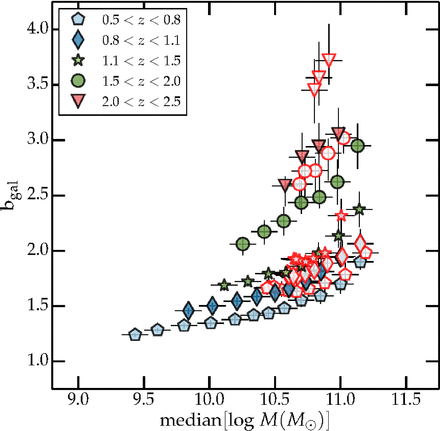We use percent-level precision photometric redshifts in the UltraVISTA-DR1 near-infrared survey to investigate the changing relationship between galaxy stellar mass and the dark matter haloes hosting them to z ∼ 2. We achieve this by measuring the clustering properties and abundances of a series of volume-limited galaxy samples selected by stellar mass and star formation activity. We interpret these results in the framework of a phenomenological halo model and numerical simulations. Our measurements span a uniquely large range in stellar mass and redshift and reach below the characteristic stellar mass to z ∼ 2. Our results are:
- (1) at fixed redshift and scale, clustering amplitude depends monotonically on sample stellar mass threshold;
- (2) at fixed angular scale, the projected clustering amplitude decreases with redshift but the comoving correlation length remains constant;
- (3) characteristic halo masses and galaxy bias increase with increasing median stellar mass of the sample;
- (4) the slope of these relationships is modified in lower mass haloes;
- (5) concerning the passive galaxy population, characteristic halo masses are consistent with a simply less-abundant version of the full galaxy sample, but at lower redshifts the fraction of satellite galaxies in the passive population is very different from the full galaxy sample;
- (6) finally, we find that the ratio between the characteristic halo mass and median stellar mass at each redshift bin reaches a peak at log (Mh/M⊙) ∼ 12.2 and the position of this peak remains constant out to z ∼ 2.

The galaxy bias for each redshift slice for the full and quiescent samples (filled and red open symbols, respectively) as a function of median stellar mass and for each redshift slice.
The behaviour of the full and passively evolving galaxy samples can be understood qualitatively by considering the slow evolution of the characteristic stellar mass in the redshift range probed by our survey.
The full paper can be found in McCracken, H.J. et al., 2015, MNRAS, 449, 901
